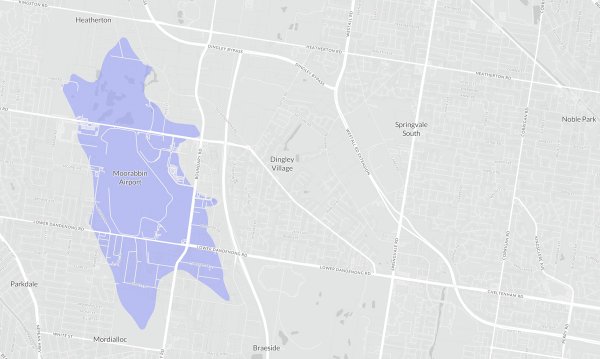Airport Environs Overlay
The Victorian government introduced the Airport Environs Overlay (AEO) and the Melbourne Airport Environs Overlay (MAEO) to identify sites that are or will be impacted by high levels of aircraft noise. It’s also used to shield people from the impact of aircraft noise by requiring appropriate noise attenuation measures in new dwellings and limiting the development of noise sensitive uses such as schools and child-care centres.
This planning overlay also helps ensure that land use and development are compatible with the operation of airports and follow the appropriate airport strategy or master plan considering safe air navigation for aircraft approaching and departing the airfield.
What happens if there is an Airport Environs Overlay on my property?
Existing homes are not affected by this overlay; however, if there is an extension or a new development, property owners or developers need to speak to the local council about how the AEO or MAEO may affect their project.
A permit is required to use land for any of the following uses:
Art and craft centre
Bar
Display home centre
Dwelling (provided no more than one is established on any lot)
Host farm
Hotel
Office
Place of assembly (except Drive-in theatre)
Research and development centre
Residential hotel
Restricted recreation facility
Small second dwelling (provided no more than one is established on any lot)
A small second dwelling must be a moveable building and only used to provide accommodation for a person dependent on a resident of the existing dwelling.
Despite the provisions of the zone, sites with AEO or MAEO must not be used for any of the following:
Accommodation (other than Dwelling, Host farm and Residential hotel and Small second dwelling)
Drive-in theatre
Education centre
Hospital
7 Key Aspects of the AEO and MAEO on Victorian Properties
When developing or purchasing properties near airports in Victoria, it’s essential to understand the Airport Environs Overlay (AEO) and its impact on land use. This overlay sets guidelines to protect both airport operations and public safety by regulating developments in nearby areas.
1. Noise Contours in Airport Environs Overlays
One of the primary considerations in the AEO and MAEO are noise management. Airports generate significant noise, especially near runways. For instance, residential developments in high-noise zones must incorporate soundproofing measures, while schools and hospitals are often discouraged in these regions due to their sensitivity to noise.
2. Height Restrictions Around Victorian Airports
Height restrictions are another important consideration of these overlays, as buildings and structures must not interfere with aircraft navigation. There are strict controls on the maximum allowable height for new construction within a certain proximity to the airport and flight paths.
3. Safety Zones and Property Development
The AEO and MAEO also includes designated safety zones to minimise the risk of aircraft accidents impacting nearby properties. These zones, typically located around runways and the approach/departure paths, impose stricter land use controls to prevent the construction of vulnerable buildings, like schools or large residential complexes, which may pose a safety risk in emergencies.
5. Managing Lighting and Glare
To ensure safe navigation, the AEO and MAEO place restrictions on lighting and glare from buildings and signs near airports. Bright lights can distract pilots, especially during nighttime operations.
6. Wildlife and Bird Control
Airports naturally attract birds and wildlife, which can pose significant risks to aircraft. The AEO and MAEO actively discourage developments that may increase wildlife activity, such as wetlands, landfills, or parks, to reduce the likelihood of bird strikes.
7. Environmental Considerations in AEO and MAEO
Lastly, environmental factors are critical in the Airport Environs Overlay. The overlay addresses stormwater management, air quality, and sustainable practices to ensure that development around airports does not negatively affect their operations.
Greenfield sites may face more stringent scrutiny to ensure they don’t pose environmental risks, particularly in terms of safety and the functionality of airport services.
For property developers, investors and home owners, understanding the Airport Environs Overlay and the Melbourne Airport Environs Overlay is crucial to making informed decisions about land use around Victorian airports.
Whether you're planning a commercial or industrial development, Landchecker can help find the information you need regarding your property including what zones and overlays cover the property and links to the planning scheme to research further.

What does my plan include?
Paid yearly Paid monthly | Starter Free | Standard | Advanced | Enterprise Contact Sales |
|---|---|---|---|---|
Additional cost per member | ||||
Property Information | ||||
... and many more | ||||
Map Views | ||||
ICEYE Flood Layer? | ||||
Metromap high resolution aerial imagery? | ||||
... and many more | ||||
Tools | ||||
Measuring tools? | ||||
Planning permit filtering? | ||||
Planning permit alerts? | 10 per member | Unlimited | Unlimited | |
Save properties to Projects? | ||||
Site Consolidation ? | ||||
... and many more | ||||
Documents & Reports | ||||
Title and Document searches? | ||||
Premium property reports | 10 per member | Unlimited | Unlimited | |
... and many more | ||||
Business Features | ||||
Credit terms available | ||||
... and many more | ||||
